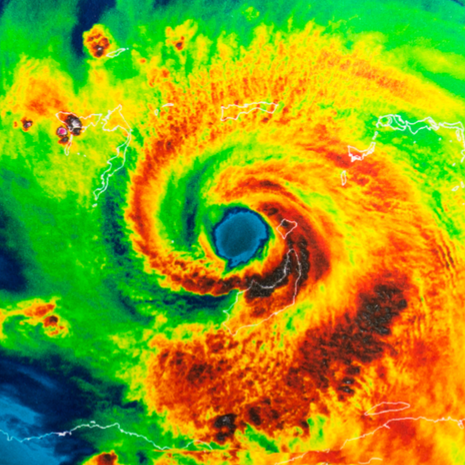“Tropical Storm Gordon has made landfall in Mississippi just west of the Alabama border, according to the National Hurricane Center. At least one death has been attributed to a fallen tree caused by the storm,” writes Bill Chappell, Vanessa Romo, and Barbara Campbell in their recent NPR article entitled “Tropical Storm Gordon Makes Landfall In Mississippi.”
According to the article, “Forecasters have urged people along the Gulf Coast from Louisiana to Florida to be wary of a dangerous storm surge and flash floods.”
“As of 2 a.m. ET, maximum sustained winds had decreased to 50 mph, with higher gusts. The storm was moving at 14 mph, some 40 miles west of Mobile, Ala,” the article continues.
“Its current path indicates it will move inland over the lower Mississippi Valley through Wednesday.”
“An oak tree fell on a mobile on the south side of Pensacola, Fla., killing one child, according to Escambia County Emergency Communications,” the writers explain.
According to the NPR piece, “The NHC says Gordon is expected to unleash a slew of hazards in several southern coastal states, including torrential rain, life-threatening inundation, powerful winds, and tornadoes.”
Now, whether your property is StormReady or not, we believe we can offer some best practices for protecting your property (and community) in the event that adverse weather hits.
Today, we’re going to share actionable, efficient ways to counter the effects of bad weather.
Are you ready?!
Adverse Weather Safety Best Practices
Below are our recommended steps for managing the impact of severe weather on your property (and your community).
It’s time to keep the tens, hundreds, and thousands of people you’re charged with protecting safe.
Whether you have guidelines in place already, are looking for a benchmark to get started, or plan to become StormReady, you must anticipate these threats.
Here are some ways to be ready for adverse weather threatening your property, and the people you protect:
An Everyday Policy
- Upon determining that weather conditions will jeopardize the safety of customers, your operations center will contact your staff to advise accordingly.
- The operations center will inform personnel to prepare to assist customers to move under shelter or to evacuate.
Move Customers to Shelter
- A public announcement will inform the customers of the threatening situation and their option to leave the property.
- Customers will be advised of safe areas to seek shelter on the property should such areas be available.
An Evacuation Order
A public service announcement (PSA) will notify customers that a report of pending weather problems requires standard operations to cease.
- Upon notice of evacuation, all personnel shall go to their assigned evacuation posts.
- All food and merchandise vendors shall close their stands, secure their inventory and lock their cash drawers. Upon stand closure, all vendors shall exit the property to a location and assemble for headcount.
Relocate Personnel to Property Gates
- Proceed to assigned gates as if the event were about to end and open the gates. If a gate key is not available, one can be obtained from the supervisor.
- Ensure that all gates are open. All turnstiles should be closed.
- Direct customers out of the property and make sure that customers do not re-enter the property.
Concourse Personnel
- Position themselves near each exit and assist in directing customers out of the property to the closest exit as quickly and efficiently as possible.
- Upon being relieved, reassemble with the supervisor at a location for headcount. Attendance will be taken.
Personnel at Ramps and Elevators
- Position themselves at each exit to the ramps and assist in directing customers out of the property as quickly and efficiently as possible.
- Calmly advise customers exiting that the escalators will not be working during an evacuation. The ramps must be used.
Seating Area Personnel
- Respond to the front of your section.
- Direct the customers out of their seating area toward the nearest exit as quickly and efficiently as possible.
- Assist the physically challenged.
- Advise any physically challenged in your area that in the case of an evacuation, the elevators will not be in service.
Event-Level, Security Personnel
- Assist the police department with escorting officials from the event level.
- Secure all event-level entrances.
- Ensure that no one can re-enter the event level except authorized personnel.
- Upon all the staff and officials exiting the property, and being relieved, reassemble with your supervisor for headcount.
Parking Operations
- Parking operations should prepare to open all exit gates.
- Parking operations should stand by for directives from the operations center concerning blocking off the gate(s) of the property perimeter road for use by emergency vehicles.
- Upon all vehicles leaving the property, parking operations will reassemble with supervisors for headcount.
Now, let’s say the weather passes your property.
Wet spots and puddles might remain.
Agree?
This scenario means incidents such as wet spills can occur.
These can quickly escalate to major medical issues, starting with a slip & fall.
You need to trust that your staff handles the aftermath appropriately.
Train them well to keep your customers (and themselves) safe.
Train Staff to Be Proactive
Train your team to execute these adverse weather methods.
They’ve got to be ready for anything!
So, set your team up for success.
Develop their knowledge of your property’s guidelines.
Show them how to mitigate incidents that stem from the after-effects of severe weather.
Be the proactive leader they need.
Use tabletop exercises to run real-life practice scenarios using the methods above.
Do it while asking and answering these seven questions:
- Do employees have the aptitude to be proactive rather than reactive in any critical situation?
- Can employees identify potential hazards before they occur?
- Who do they communicate with first when an incident such as a slip & fall occurs?
- How do they handle a scenario where someone is injured during an evacuation?
- Does your team know how to use your incident management mobile app to follow protocols to handle?
- Can your team communicate with the operations center and others effectively?
- How efficiently can they report an incident using your mobile app?
Deliver the safest experience.
Practice like everyone’s life depends on it because it just might one of these days.
Use Your Incident Management System
Training your employees on the procedures above is a good practice.
But, don’t rely on them to recall every aspect of training.
Certain types of situations don’t always happen, which means they’ll likely forget how to perform when the times comes.
You need everything communicated effectively and in real time.
You also need your team to execute these protocols efficiently.
Put the right incident management infrastructure in place to get real-time data.
Have communication throughout all your personnel.
Real-time communication is the only way to receive real-time data.
It’s especially important during severe weather.
You must eliminate poor communication and how it affects the safety of your customers.
So, how do you accomplish this?
An Incident management system (IMS) helps your team communicate and understand the information needed during weather-related instances.
Enhance Real-Time Communications Using Incident Management Mobile Apps
Don’t stop at your IMS.
Enhance your real-time communications (and solution) with incident management mobile apps.
These apps will help your operations center communicate protocols efficiently.
- Frontline staff can report incidents in seconds
- Have all the associated event information in your system
- The data will be transmitted to your entire team with a couple of clicks of a button
- Mobile staff can communicate on the fly with operations center personnel
What does all of this help you achieve?
Faster response times.
Everyone is being notified simultaneously and without communication bottlenecks.
The system captures all the actions associated with an incident.
Then, it communicates proper protocols to your teams.
Let’s say that a high priority incident occurs because of your most recent evacuation.
Your staff doesn’t hesitate with an implemented system.
- All need-to-know information populates on mobile devices
- Your team acts
- They mitigate the incident and your evacuation proceeds
How professional does your team look?
We think you know the answer.
This ability is Proactive Operations.
Do you see how having all the following safeguards in place can help you prepare your property for unfavorable weather?
- Methods for managing weather-related scenarios
- Trained and high-performing employees
- Incident management system to synchronize efforts
- Incident management mobile apps to boost team efficiency
Preparation like this is how you keep your customers, property, and community safe any time you’re needed.
Over to You
Now a tropical depression, Gordon is still on its destructive path filled with rainfall that could result in severe flooding through today. So, while we may not be able to do much, we offer these guidelines to you for consideration.
You don’t know when the adverse weather will hit your property. But, taking the time to prepare now will ensure the safety of your customers when the time comes.
Are you prepared?




